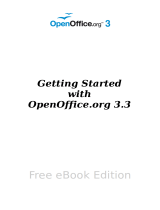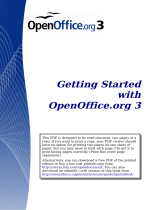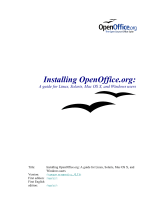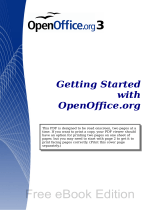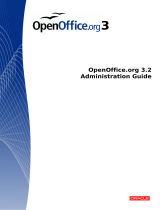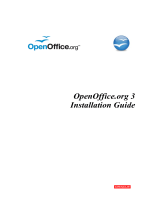Page is loading ...

Novell®
www.novell.com
novdocx (en) 11 July 2008
AUTHORIZED DOCUMENTATION
Novell ZENworks Application Virtualization 6.1 Integration Guide
ZENworks
®
Application Virtualization
6.1
October 17, 2008
Integration Guide

novdocx (en) 11 July 2008
Legal Notices
Novell, Inc., makes no representations or warranties with respect to the contents or use of this documentation, and
specifically disclaims any express or implied warranties of merchantability or fitness for any particular purpose.
Further, Novell, Inc., reserves the right to revise this publication and to make changes to its content, at any time,
without obligation to notify any person or entity of such revisions or changes.
Further, Novell, Inc., makes no representations or warranties with respect to any software, and specifically disclaims
any express or implied warranties of merchantability or fitness for any particular purpose. Further, Novell, Inc.,
reserves the right to make changes to any and all parts of Novell software, at any time, without any obligation to
notify any person or entity of such changes.
Any products or technical information provided under this Agreement may be subject to U.S. export controls and the
trade laws of other countries. You agree to comply with all export control regulations and to obtain any required
licenses or classification to export, re-export or import deliverables. You agree not to export or re-export to entities on
the current U.S. export exclusion lists or to any embargoed or terrorist countries as specified in the U.S. export laws.
You agree to not use deliverables for prohibited nuclear, missile, or chemical biological weaponry end uses. See the
Novell International Trade Services Web page (http://www.novell.com/info/exports/) for more information on
exporting Novell software. Novell assumes no responsibility for your failure to obtain any necessary export
approvals.
Copyright © 2008 Novell, Inc. All rights reserved. No part of this publication may be reproduced, photocopied,
stored on a retrieval system, or transmitted without the express written consent of the publisher.
Novell, Inc., has intellectual property rights relating to technology embodied in the product that is described in this
document. In particular, and without limitation, these intellectual property rights may include one or more of the U.S.
patents listed on the Novell Legal Patents Web page (http://www.novell.com/company/legal/patents/) and one or
more additional patents or pending patent applications in the U.S. and in other countries.
Novell, Inc.
404 Wyman Street, Suite 500
Waltham, MA 02451
U.S.A.
www.novell.com
Online Documentation: To access the latest online documentation for this and other Novell products, see
the Novell Documentation Web page (http://www.novell.com/documentation).

novdocx (en) 11 July 2008

Contents 5
Contents
novdocx (en) 11 July 2008
About This Guide 7
1Overview 9
1.1 Using the Configuration Wizard to Prepare Applications for Virtualization. . . . . . . . . . . . . . . . . 9
1.2 Manually Preparing Applications for Virtualization . . . . . . . . . . . . . . . . . . . . . . . . . . . . . . . . . . 11
2 Preparing GroupWise Messenger for Virtualization 13
3 Preparing GroupWise and GroupWise Notify for Virtualization 17
4 Preparing Novell OpenOffice for Virtualization 21

6 Novell ZENworks Application Virtualization 6.1 Integration Guide
novdocx (en) 11 July 2008

About This Guide 7
novdocx (en) 11 July 2008
About This Guide
This guide provides information about using Novell
®
ZENworks
®
Application Virtualization to
prepare Novell products for use in your environment. The information in this guide is organized as
follows:
Chapter 1, “Overview,” on page 9
Chapter 2, “Preparing GroupWise Messenger for Virtualization,” on page 13
Chapter 3, “Preparing GroupWise and GroupWise Notify for Virtualization,” on page 17
Chapter 4, “Preparing Novell OpenOffice for Virtualization,” on page 21
Audience
This guide is intended for administrators.
Feedback
We want to hear your comments and suggestions about this manual and the other documentation
included with this product. Please use the User Comments feature at the bottom of each page of the
online documentation, or go to Novell Documentation Feedback site (http://www.novell.com/
documentation/feedback.html) and enter your comments there.
Documentation Updates
For the most recent version of the ZENworks Application Virtualization 6.1 Integration Guide, visit
the Novell Documentation Web site (http://www.novell.com/documentation/zav61).
Additional Documentation
ZENworks Application Virtualization is supported by other documentation (in PDF format) that you
can use to learn about and implement the product. For additional documentation, see the ZENworks
Application Virtualization Web site (http://www.novell.com/documentation/zav61/index.html). You
can also click Help > Novell ZENworks Application Virtualization from within the program to
access this information.
Documentation Conventions
In Novell documentation, a greater-than symbol (>) is used to separate actions within a step and
items in a cross-reference path.
A trademark symbol (
®
,
TM
, etc.) denotes a Novell trademark. An asterisk (*) denotes a third-party
trademark.
When a single pathname can be written with a backslash for some platforms or a forward slash for
other platforms, the pathname is presented with a backslash. Users of platforms that require a
forward slash, such as Linux* or UNIX*, should use forward slashes as required by your software.

8 Novell ZENworks Application Virtualization 6.1 Integration Guide
novdocx (en) 11 July 2008

Overview
1
9
novdocx (en) 11 July 2008
1
Overview
Novell
®
ZENworks
®
Application Virtualization 6.1 IR1 lets you convert applications that run on
Microsoft* Windows* into self-contained virtual applications. After being virtualized, an
application becomes a single, isolated file that runs instantly from anywhere, including a thumb
drive or other removable media. Unlike traditional installation methods, the single virtual
application file does not require a separate setup process, and does not rely on external components
and runtimes, reboots, or administrative privileges. The application is now isolated from other
system applications, preventing DLL conflicts and other deployment nightmares, yet the experience
for the application’s user is unchanged.
NOTE: ZENworks Application Virtualization 6.1 IR1 lets you use the Configuration Wizard to
prepare Novell GroupWise
®
, GroupWise Messenger, and Novell OpenOffice for virtualization. In
the previous version (6.1), the Configuration Wizard did not include the ability to virtualize these
Novell applications.
To virtualize GroupWise, GroupWise Messenger, and Novell OpenOffice, you have the following
options:
Use the options in the Configuration Wizard to virtualize these applications. This process is
recommended for first time users.
For more information, see Section 1.1, “Using the Configuration Wizard to Prepare
Applications for Virtualization,” on page 9.
Configure these applications manually.
This guide provides step-by-step information to help you use Novell ZENworks Application
Virtualization to create virtual executable files to run Novell GroupWise, GroupWise Notify,
GroupWise Messenger, and Novell OpenOffice. You cannot currently use the wizard to
virtualize GroupWise Notify.
You can use the information in this guide to customize the virtualized files or you can use the
information to better understand the virtualization process. For more information, see
Section 1.2, “Manually Preparing Applications for Virtualization,” on page 11
1.1 Using the Configuration Wizard to Prepare
Applications for Virtualization
ZENworks Application Virtualization includes a Configuration Wizard that helps you prepare the
following common applications for virtualization:
Adobe* Reader 8
Gimp 2
Internet Explorer* 6
Microsoft Office Professional 2003
Microsoft Office Professional 2007
Microsoft Ultimate 2007
Mozilla* Firefox* 2

10 Novell ZENworks Application Virtualization 6.1 Integration Guide
novdocx (en) 11 July 2008
Mozilla Firefox 3
Novell GroupWise Client
Novell GroupWise Messenger
Novell OpenOffice 2.4.1
OpenOffice 2
To use the Configuration Wizard to virtualize GroupWise, GroupWise Messenger, or Novell
OpenOffice:
1 Click Start > Programs > Novell ZENworks Application Virtualization > Novell ZENworks
Application Virtualization to start the application.
2 Click the Configuration Wizard button in the Tools section of the Virtual Application ribbon.
3 Click Build an auto-configured virtual application.

Overview 11
novdocx (en) 11 July 2008
4 Select the desired application from the Application drop-down list.
5 Click Next, then follow the instructions in the wizard.
1.2 Manually Preparing Applications for
Virtualization
Most commercial applications, including GroupWise and Novell OpenOffice, require complex
combinations of file system and registry entries to function properly. To facilitate virtualization of
these applications, ZENworks Application Virtualization creates snapshot application installations
and automatically configures itself based on modifications made to the host system during
application setup.
Snapshotting uses images of the host machine that are taken at different points in time to determine
the virtual application configuration.
Prior to installing the application to be virtualized, a snapshot is taken that captures the state of the
host device without the target application installed. After installing the application, a second
snapshot is taken that captures all changes to the host device. ZENworks Application Virtualization
then computes the changes, or delta, between the snapshots, and inserts these changes into the
configuration.
You can use the configuration information to create executable files that behave differently,
depending on the application you are preparing to use:
A Single Executable File to Launch an Application: To prepare GroupWise Messenger, you
can create a single executable file to launch the program. For more information, see Chapter 2,
“Preparing GroupWise Messenger for Virtualization,” on page 13.
To prepare Novell OpenOffice, you have the option to create a single executable file to launch
the OpenOffice.org Quickstarter, which lets users choose the program to launch (Writer, Calc,
Draw, Impress, or Math). For more information, see Chapter 4, “Preparing Novell OpenOffice
for Virtualization,” on page 21.
A Single Executable File to Simultaneously Launch Multiple Applications: To prepare
GroupWise and Notify, you can create a single executable file to launch both programs
simultaneously. For more information, see Chapter 3, “Preparing GroupWise and GroupWise
Notify for Virtualization,” on page 17.
A Single Executable File to Expose Multiple Executable Startup Files: To prepare Novell
OpenOffice, you can create a single executable file to expose multiple executable startup files
(Writer, Calc, Draw, Impress, or Math). ZENworks Application Virtualization allows multiple
entry points into the virtual application to be triggered based on a command line argument to
the virtual application executable. If you use Novell ZENworks Desktop Management or
ZENworks Configuration Management to distribute applications, command line arguments let
you use the same application object for all OpenOffice.org programs. For more information,
see Chapter 4, “Preparing Novell OpenOffice for Virtualization,” on page 21.

12 Novell ZENworks Application Virtualization 6.1 Integration Guide
novdocx (en) 11 July 2008

Preparing GroupWise Messenger for Virtualization
2
13
novdocx (en) 11 July 2008
2
Preparing GroupWise Messenger
for Virtualization
The section contains step-by-step information to help you use Novell
®
ZENworks
®
Application
Virtualization to prepare Novell GroupWise
®
Messenger to run as a virtual application.
1 Install ZENworks Application Virtualization onto a clean machine.
You can prepare a clean machine by uninstalling GroupWise Messenger. However, we
recommend that you start the process on a machine that has only the desired Windows OS, any
applicable OS service packs, and ZENworks Application Virtualization installed. Starting with
a machine that includes only these items helps to ensure that your virtual application does not
contain settings that might cause conflicts.
2 Click Start > Programs > Novell ZENworks Application Virtualization > Novell ZENworks
Application Virtualization to start the application.
3 Click Capture Before in the Snapshot section of the Virtual Application ribbon.

14 Novell ZENworks Application Virtualization 6.1 Integration Guide
novdocx (en) 11 July 2008
This process captures the first snapshot image. Snapshotting iterates through the file system
and registry, and therefore might take several minutes to complete.
4 (Optional) Click the down-arrow on the bottom of the Capture Before button, then click Save
Snapshot.
Saving the first snapshot lets you skip this step when snapshotting subsequent applications
from the same clean machine image.
5 Install GroupWise Messenger on the clean machine.
For installation instructions, see the GroupWise Documentation Web site (http://
www.novell.com/documentation/groupwise.html). Depending on the version of GroupWise
that you have deployed in your environment, click the appropriate link, then locate and display
the Installation Guide.
6 Click Capture and Diff in the Snapshot section of the Virtual Application ribbon.
7 Browse to and select the destination folder to store the snapshot, then click OK.
This process captures the second snapshot, computes the delta between the two snapshots, and
populates the virtual application with the delta entries. This process might take a few minutes.
8 (Optional) Click the Filesystem button on the left side of the ZENworks Application
Virtualization console to review the file system and registry entries.
You can remove any files or settings that are not required for proper execution of your virtual
application. Removing unused entries reduces virtual application size. However, accidental
removal of a required resource might cause your virtual application to not function properly.
9 From the Startup File drop-down list, select the GroupWise Messenger executable file
(NMCL32.exe).
10 Click Build in the Build section of the Virtual Application ribbon to process the application.

Preparing GroupWise Messenger for Virtualization 15
novdocx (en) 11 July 2008
11 Specify the location and filename of the virtual application executable file.
12 Test the virtual application executable file on another machine.
The executable file is now ready to distribute to users. You can use any method you want to
distribute the file, including USB thumb drives.
You can also use Novell ZENworks or Novell ZENworks Configuration Management to distribute
the file. For more information, see the ZENworks Documentation Web site (http://www.novell.com/
documentation/zenworks.html).
Users must authenticate to the GroupWise Messenger system after they launch the virtual
application.

16 Novell ZENworks Application Virtualization 6.1 Integration Guide
novdocx (en) 11 July 2008

Preparing GroupWise and GroupWise Notify for Virtualization
3
17
novdocx (en) 11 July 2008
3
Preparing GroupWise and
GroupWise Notify for
Virtualization
The section contains step-by-step information to help you use Novell
®
ZENworks
®
Application
Virtualization to prepare Novell GroupWise
®
and GroupWise Notify to run as virtual applications.
1 Install ZENworks Application Virtualization onto a clean machine.
You can prepare a clean machine by uninstalling GroupWise and GroupWise Notify. However,
we recommend that you start the process on a machine that has only the desired Windows OS,
any applicable OS service packs, and ZENworks Application Virtualization installed. Starting
with a machine that includes only these items helps to ensure that your virtual application does
not contain settings that might cause conflicts.
2 Click Start > Programs > Novell ZENworks Application Virtualization > Novell ZENworks
Application Virtualization to start the application.
3 Click Capture Before in the Snapshot section of the Virtual Application ribbon.

18 Novell ZENworks Application Virtualization 6.1 Integration Guide
novdocx (en) 11 July 2008
This process captures the first snapshot image. Snapshotting iterates through the file system
and registry, and might take several minutes to complete.
4 (Optional) Click the down-arrow on the bottom of the Capture Before button, then click Save
Snapshot.
Saving the first snapshot lets you skip this step when snapshotting subsequent applications
from the same clean machine image.
5 Install GroupWise on the clean machine.
For installation instructions, see the GroupWise Documentation Web site (http://
www.novell.com/documentation/groupwise.html). Depending on the version of GroupWise
that you have deployed in your environment, click the appropriate link, then locate and display
the Installation Guide.
6 Click Capture and Diff in the Snapshot section of the Virtual Application ribbon.
7 Browse to and select the destination folder to store the snapshot, then click OK.
This process captures the second snapshot, computes the delta between the two snapshots, and
populates the virtual application with the delta entries. This process might take a few minutes.
8 (Optional) Click the Filesystem button on the left side of the ZENworks Application
Virtualization console to review the file system and registry entries.
You can remove any files or settings that are not required for proper execution of your virtual
application. Removing unused entries reduces virtual application size. However, accidental
removal of a required resource might cause your virtual application to not function properly.
9 (Conditional) If you plan to use the GroupWise Caching mode or the Archive feature, click the
Filesystem button on the left side of the ZENworks Application Virtualization console, then
add the sandbox data area folders you want to embed in the application executable to store
cached or archived data. For example, you could created a Cache folder and an Archive
folder for users.
Caching mode stores a copy of a user’s network mailbox, including messages and other
information, on a local drive. The archive saves mail or phone messages, appointments,
reminder notes, or tasks to a designated database on a local drive. For more information, see the
GroupWise Documentation Web site (http://www.novell.com/documentation/groupwise.html).
Ensure that you have enough disk space in your ZENworks Application Virtualization sandbox
to store that mailbox. For information, see the Configuring the sandbox location topic in online
help (click Help > click Novell ZENworks Application Virtualization Documentation > expand

Preparing GroupWise and GroupWise Notify for Virtualization 19
novdocx (en) 11 July 2008
the Virtual Application Customization book > click Configuring the sandbox location) or see
the Editing the virtual filesystem topic in the online help (expand the Configuring Virtual
Applications book > click Editing the virtual filesystem).
10 From the Startup File drop-down list, select the GroupWise executable file (grpwise.exe).
11 Click the Multiple button on the right side of the Startup File drop-down list to display the
Startup Files dialog box.
ZENworks Application Virtualization lets you launch both GroupWise and Notify when users
click the virtual application executable file.
11a Click the File column on the first empty row in the startup file list and select
notify.exe, then press Enter.
11b Click the Auto Start check box next to notify.exe so that it is always automatically
launched on virtual application startup along with GroupWise.
The Auto Start flag can be specified for multiple startup files to automatically launch
multiple applications that are typically used together in a single session (also known as
shotgunning).
12 Click Build in the Build section of the Virtual Application ribbon to process the application.
13 Specify the location and filename of the virtual application executable file.
14 Test the virtual application executable file on another machine.
The executable file is now ready to distribute to users. You can use any method you want to
distribute the file, including USB thumb drives.

20 Novell ZENworks Application Virtualization 6.1 Integration Guide
novdocx (en) 11 July 2008
You can also use Novell ZENworks or Novell ZENworks Configuration Management to distribute
the file. For more information, see the ZENworks Documentation Web site (http://www.novell.com/
documentation/zenworks.html).
Users must authenticate to the GroupWise system after they launch the virtual application. The
virtual application executable, as configured above, does not populate the username, password, or
post office information. When the user logs in to the virtual GroupWise application the first time, the
user can choose to save this information.
Users can use the virtualized GroupWise application on a machine that already has GroupWise
installed. However, both instances of GroupWise cannot run at the same time. The authentication
and post office information for the installed instance are not used for the virtualized instance of
GroupWise.
The virtual executable file can be used to run GroupWise in Online, Remote, or Caching mode. For
more information on these modes, see the GroupWise Documentation Web site (http://
www.novell.com/documentation/groupwise.html).
/

